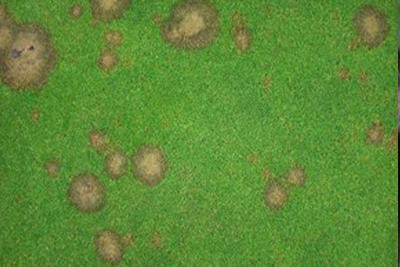The majority of turf diseases are caused by fungal pathogens but some fungi are more strongly pathogenic than others. Many of the common cool season turf diseases are caused by fungi that rely on a weakened plant and therefore reducing disease incidence and severity is often aligned to maintaining a strong sward. With on-going changes to European Legislation relating to pesticide use, it is more important than ever that an integrated approach to disease management is employed and central to this is an understanding that the cultural conditions can limit disease development. Making use of the genetic variation that exists between grass types and cultivars can also minimise disease development through a sward. By managing rootzone quality and using weather information services, it can also be possible to pre-empt disease outbreaks and plan an efficient integrated management strategy.
Cultural & Chemical Prevention
Several cultural measures can be taken to reduce disease incidence: aeration, top dressing, drainage, scarification, acidifying the surface, removal of trees blocking light and airflow and the use of well-timed and ‘just enough – not excessive’ nutrition to maintain plant health without forcing ‘soft growth’ that is prone to disease.
Recent research suggests that the traditional autumn application of large amounts of potassium as a ‘hardener’ to reduce disease is ineffective at best, and possibly causing more harm than good. Research at the University of Nebraska suggests that excess potassium in plant tissues increased the plants susceptibility to microdochium. Many UK Turf Managers are now reporting similar findings after reducing autumn K applications to more moderate levels.
Fungicide Only Options:
Curative:
- Propiconazole* (Nimble Pro)
- Tebuconazole + Trifloxystrobin (Tebloxy)
Preventative:
- Propiconazole* (Nimble Pro)
- Azoxystrobin (Pure Azoxy)
- Tebuconazole + Trifloxystrobin (Tebloxy)
- Fludioxonil (Medallion TL)
- Trifloxystrobin (Aquarius)
Fungicide Tank Mixes:
- 1l Tebloxy + 4l TKO Phosphite + 20l X-Xtra Iron + 10l pH Reducer
- 3l Nimble Pro + 20l X-Xtra Iron + 2.8l Pure Kelp SA
- 3l Nimble Pro + 10l pH Reducer + 10l X-Xtra Iron
- 500g Pure Azoxy 4l TKO Phosphite
- 700g Aquarius + 5l Fulvic Acid + 20l X-Xtra Iron

Example of Microdochium Patch
Symptoms
Initial symptoms are small dark brown spots of watersoaked turf that will continue to spread into larger patches if conditions allow. The outer edge of the patch often shows as a darker brown than the centre whilst the infection is spreading outwards and there can be visible fluffy light pink mycelium here too.

Mild, damp weather brings on disease development. Note the distinctive lighter centre and darker brown outer ring of active microdochium.
Cold, frosty weather will halt disease development, but when temperatures pick up and moisture is still prevalent, disease activity will pick up too.
Non-Pesticidal microdochium prevention:
Use Sustane 4.6.4 as an early season base feed to maximise soil and plant health. Use Sustane 5.2.4, 5.2.10 or 10.2.10 if using a granular programme to promote low yield, healthy growth. Foliar programmes should use Classic 18.3.6, K-Builder 7.2.21, Pot Carb Max, Nitro 30 or Quick Response 20.3.3 alongside TKO Phosphite/X-Xtra Iron and should look to reduce K applications going into the peak disease season. Utilise biostimulants such as Essential Plus or Pure Kelp SA to condition soils and reduce plant stress. If microdochium pressure is high, acidify the leaf surface to reduce infection using citric acid (pH Reducer) or a low pH chelated iron (X-Xtra Iron).
A cultural programme of management throughout the growing season is important to enable surfaces to perform well with reduced reliance on chemical applications all year round.

